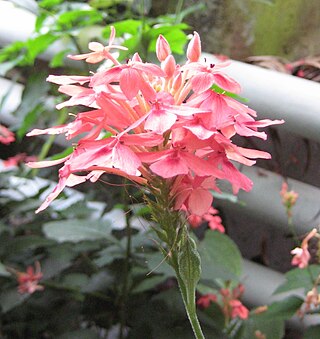
The Aizoaceae, or fig-marigold family, is a large family of dicotyledonous flowering plants containing 135 genera and about 1800 species. Several genera are commonly known as 'ice plants' or 'carpet weeds'. The Aizoaceae are also referred to as vygies in South Africa and New Zealand. Some of the unusual Southern African genera—such as Conophytum, Lithops, Titanopsis and Pleiospilos —resemble gemstones, rocks or pebbles, and are sometimes referred to as 'living stones' or 'mesembs'.

Mesembryanthemum is a genus of flowering plants in the family Aizoaceae, indigenous to southern Africa. As with many members of that family, it is characterized by long-lasting flower heads. Flowers of Mesembryanthemum protect their gametes from night-time dews or frosts but open in sunlight. There is an obvious evolutionary advantage to doing this; where sun, dew, frost, wind or predators are likely to damage exposed reproductive organs, closing may be advantageous during times when flowers are unlikely to attract pollinators.
Aptenia was a small genus of flowering plants in the family Aizoaceae, which as of January 2024 was treated as a synonym of the genus Mesembryanthemum. Species formerly placed in the genus are native to southern Africa. The genus name is from the Greek a- (not) and ptenos (winged), and refers to the wingless fruit capsules.

Antimima is a succulent plant genus in the family Aizoaceae, indigenous to South Africa and Namibia.

Juttadinteria is a genus of plants in the family Aizoaceae.

Glottiphyllum is a genus of about 57 species of succulent subtropical plants of the family Aizoaceae. It is closely related to the Gibbaeum and Faucaria genera. The name comes from ancient Greek γλωττίς glottis "tongue" and φύλλον phyllon "leaf". The species are native to South Africa, specifically to Cape Province and the Karoo desert. They grow in rocks and soils incorporating slate, sandstone and quartz. Rainfall in their native areas is between 125 and 500 mm, most of which falls in March and November.

Pleiospilos nelii, the split rock, splitrock or living granite, is a species of flowering plant in the family Aizoaceae, native to South Africa. It grows in semi-arid areas with rainfall of between 150mm and 300mm, in the Karoo of South Africa.

Neohenricia is a genus of flowering plants in the family Aizoaceae, native to South Africa. Low-lying succulents, they are found in places that can collect a little water, such as crevices and pans, on sandstone or dolorite, in areas that get at least 200 mm of rainfall annually.

Wooleya is a monotypic genus of flowering plants belonging to the family Aizoaceae. It only contains one known species, Wooleya farinosa. It is also in tribe Ruschieae.

Vanzijlia is a genus of flowering plants belonging to the family Aizoaceae. It only contains one known species, Vanzijlia annulata.

Vanheerdea is a genus of flowering plants belonging to the family Aizoaceae. It is also in Tribe Ruschieae.
Hammeria is a genus of flowering plants belonging to the family Aizoaceae.
Jacobsenia is a genus of flowering plants belonging to the family Aizoaceae.
Leipoldtia is a genus of flowering plants belonging to the family Aizoaceae.
Mossia is a monotypic genus of flowering plants belonging to the family Aizoaceae. It only contains one known species, Mossia intervallaris.
Ottosonderia is a genus of flowering plants belonging to the family Aizoaceae.
Rabiea is a genus of flowering plants belonging to the family Aizoaceae.
Marlothistella is a genus of flowering plants belonging to the family Aizoaceae. It is native to the Cape Provinces of South Africa.
Peersia is a genus of flowering plants belonging to the family Aizoaceae.

Ruspolia is a genus of flowering plants belonging to the family Acanthaceae.











